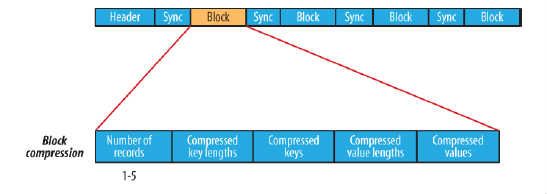Hadoop中的SequenceFile和MapFile
SequenceFile
1. SequenceFile概述
1.1.sequenceFile文件是Hadoop用来存储二进制形式的
1.2.可以把SequenceFile当做是一个容器,把所有的文件打包到SequenceFile类中可以高效的对小文件进行存储和处理。
1.3.SequenceFile文件并不按照其存储的Key进行排序存储,SequenceFile的内部类Writer提供了append功能。
1.4.SequenceFile中的Key和Value可以是任意类型Writable或者是自定义Writable。
1.5.在存储结构上,SequenceFile主要由一个Header后跟多条Record组成,Header主要包含了Key classname,value classname,存储压缩算法,用户自定义元数据等信息,此外,还包含了一些同步标识,用于快速定位到记录的边界。每条Record以键值对的方式进行存储,用来表示它的字符数组可以一次解析成:记录的长度、Key的长度、Key值和value值,并且Value值的结构取决于该记录是否被压缩。
2:SequenceFile压缩
2.1.SequenceFIle的内部格式取决于是否启用压缩,如果是压缩,则又可以分为记录压缩和块压缩。
2.2.有一下三种类型的压缩:
A.无压缩类型:如果没有启用压缩(默认设置)那么每个记录就由它的记录长度(字节数)、键的长度,键和值组成。长度字段为4字节。
B.记录压缩类型:记录压缩格式与无压缩格式基本相同,不同的是值字节是用定义在头部的编码器来压缩。注意:键是不压缩的。下图为记录压缩:
C.块压缩类型:块压缩一次压缩多个记录,因此它比记录压缩更紧凑,而且一般优先选择。当记录的字节数达到最小大小,才会添加到块。该最小值由io.seqfile.compress.blocksize中的属性定义。默认值是1000000字节。格式为记录数、键长度、键、值长度、值。下图为块压缩:
3.SequenceFile写文件的示例:
/**
* 写过程:
* 1):创建Configuration
* 2):获取FileSystem
* 3):创建文件输出路径Path
* 4):调用SequenceFile.createWriter()方法得到SequenceFile.Writer对象
* 5):调用SequenceFile.Writer的append()方法将内容追加到文件。
* 6):关闭流
* @author 廖钟民
* time : 2015年2月2日下午3:57:59
* @version
*/
public class SequenceFileWriter {
//定义压缩的路径
private static final String URL = "hdfs://liaozhongmin:9000";
public static void main(String[] args) {
try {
//创建配置信息
Configuration conf = new Configuration();
//创建文件系统
FileSystem fileSystem = FileSystem.get(new URI(URL), conf);
//压缩后的文件名称
Path path = new Path(URL + "/tmp.seq");
//创建SequenceFile.Writer对象
//Writer writer = SequenceFile.createWriter(fileSystem, conf, path, Text.class, Text.class);
Writer writer = SequenceFile.createWriter(fileSystem,conf, path, Text.class, Text.class, CompressionType.BLOCK, new BZip2Codec());
//通过writer想文档中写入记录
writer.append(new Text("name"), new Text("lavimer"));
//关闭writer
IOUtils.closeStream(writer);
} catch (Exception e) {
e.printStackTrace();
}
}
}
4.SequenceFile读取文件示例:
/**
* 读过程:
* 1):创建Configuration
* 2):获取FileSystem
* 3):创建文件输出路径Path
* 4):new一个SequenceFile.Reader获取对象
* 5):得到KeyClass和ValueClass
* 6):关闭流
* @author 廖钟民
* time : 2015年2月2日下午4:00:25
* @version
*/
public class SequenceFileReader {
//定义文件读取的路径
private static final String INPATH = "hdfs://liaozhongmin:9000";
public static void main(String[] args) {
try {
//创建配置信息
Configuration conf = new Configuration();
//创建文件系统
FileSystem fs = FileSystem.get(new URI(INPATH),conf);
//创建Path对象
Path path = new Path(INPATH + "/tmp.seq");
//创建SequenceFile.Reader对象
SequenceFile.Reader reader = new SequenceFile.Reader(fs, path, conf);
//创建Key和value
Text key = new Text();
Text value = new Text();
//从tmp.seq中循环读取内容
while (reader.next(key, value)){
System.out.println("key=" + key);
System.out.println("value=" + key);
System.out.println("position=" + reader.getPosition());
}
//关闭资源
IOUtils.closeStream(reader);
} catch (Exception e) {
e.printStackTrace();
}
}
}
5.SequenceFile总结
5.1 SequenceFile优点:
A.支持基于记录(Record)或块(Block)的数据压缩。
B.支持splitable,能够作为MapReduce的输入分片。
C.修改简单:主要负责修改相应的业务逻辑,而不用考虑具体的存储格式。
5.2 SequenceFile的缺点
A.需要一个合并文件的过程,且合并后的文件不方便查看。
MapFile
1.MapFile概述
1.1.MapFile是排序后的SequenceFile,通过观察其目录结构可以看到MapFile由两部分组成分别是data和index。
1.2.index作为文件的数据索引,主要记录了每个Record的Key值,以及该Record在文件中的偏移位置。在MapFile被访问的时候,索引文件会被加载到内存,通过索引映射关系可以迅速定位到指定Record所在文件位置,因此,相对SequenceFile而言,MapFile的检索效率是最高的,缺点是会消耗一部分内存来存储index数据。
1.3.需要注意的是,MapFile并不不会把所有的Record都记录到index中去,默认情况下每隔128条记录会存储一个索引映射。当然,记录间隔可认为修改,通过MapFile.Writer的setIndexInterval()方法,或修改io.map.index.interval属性。
1.4.与SequenceFile不同的是,MapFile的KeyClass一定要实现WritableComparable接口,即Key值是可比较的。
2.MapFile写文件示例:
/**
* MapFile写过程
* 1.创建Configuration
* 2.获取FileSystem
* 3.创建文件输出路径Path
* 4.new一个MapFile.Writer对象
* 5.调用MapFile.Writer.append()方法追加写入
* 6.关闭流
* @author 廖钟民
* time : 2015年2月2日下午4:13:42
* @version
*/
public class MapFileWriter {
//定义压缩的路径
private static final String URL = "hdfs://liaozhongmin:9000";
public static void main(String[] args) {
try {
//1.创建Configuration
Configuration conf = new Configuration();
//2.获取FileSystem
FileSystem fileSystem = FileSystem.get(new URI(URL), conf);
//3.创建文件输出路径Path
Path path = new Path(URL + "/mapfile");
//4.new一个MapFile.Writer对象
MapFile.Writer writer = new MapFile.Writer(conf, fileSystem, path.toString(), Text.class, Text.class);
//5.调用MapFile.Writer.append()方法追加写入
writer.append(new Text("name"), new Text("liaozhongmin"));
//关闭流
writer.close();
} catch (Exception e) {
// TODO: handle exception
}
}
}
3.MapFile读文件示例:
/**
* MapFile读文件
* 1.创建Configuration
* 2.获取FileSystem
* 3.创建文件输出路径Path
* 4.new一个MapFile.Reader进行读取
* 5.得到KeyClass和ValueClass
* 6.关闭流
* @author 廖钟民
* time : 2015年2月2日下午4:30:17
* @version
*/
public class MapFileReader {
//定义文件读取的路径
private static final String INPATH = "hdfs://liaozhongmin:9000";
public static void main(String[] args) {
try {
//创建配置信息
Configuration conf = new Configuration();
//创建文件系统
FileSystem fs = FileSystem.get(new URI(INPATH),conf);
//创建Path对象
Path path = new Path(INPATH + "/mapfile");
//4.new一个MapFile.Reader进行读取
MapFile.Reader reader = new MapFile.Reader(fs, path.toString(), conf);
//创建Key和Value
Text key = new Text();
Text value = new Text();
//遍历获取结果
while (reader.next(key, value)){
System.out.println("key=" + key);
System.out.println("value=" + value);
}
//关闭流
IOUtils.closeStream(reader);
} catch (Exception e) {
e.printStackTrace();
}
}
}

